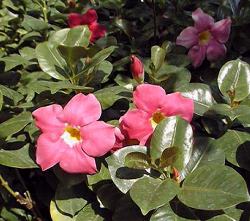
|
|
Dipladenia (Dipladenia
sanderii)
|
Dipladenia (Dipladenia sanderii)
Dipladenia sanderii or Brazilian Jasmine
is a plant belongs to genus mandevilla. The genus Mandevilla
consists of more than 100 species of woody twining vines and shrubs,
native to tropical America. The
name Mandevilla is in honor of the nineteenth century British Minister in Buenos
Aires, Henry John Mandeville. The
name sanderii named
for Henry Frederick Conrad Sander, early 20th century German-born British nurseryman who specialized in
orchids.
Dipladenia or
Mandevilla sanderii is a very different
looking and growing plant from other mandevillas. Botanically they are all
mandevillas, but
tradionally this plant has been called dipladenia. Dipladenias have
smaller leathery leaves and have very little climbing habit. Usually they
are grown as a container plant or a semi-hanging basket. The original
original dipladenias were a very pale pink flower and it was discovered in
the highlands above Rio de Janeiro Brazil
toward the end of the nineteenth century and has not been found in the
wild since. History indicates that perhaps only
one plant was found and it is not found growing in nature down there now.
Probably all condo's!!
Dipladenias have come a long way from the original pale
pink. We now
have Red Riding Hood in a cherry pink/red, Scarlett Pimpernel with a
brighter. These Dipladenias are sports from a
hybrid of M. xamabilis and M.
sanderi. A sport is a plant that is significantly
different from its parents due to mutation rather than hybridization due
to cross-pollination. Rather than a vine,
Dipladenia is a sprawling shrub that
can be trained on a trellis, but also looks and does fine as a shrub. The
dark green, glossy leaves are only about 2 inches long and are ovate or
elliptic in shape. Dipladenia will bloom whenever the temperature is above
50 degrees fahrenheit at night. The showy, rose-pink, tubular flowers are borne
laterally in clusters of 3 to 5. Each flower is nearly 2 inches long by 2Ĺ
to 3 inches across, very deep pink
to red blossoms with a deep yellow throat. The flowers are shaped like a
typical mandevilla except fort the petals being somewhat curved backward
at their tips.
Source:
http://www.butterflies.org/hortcltr3.cfm?plantID=97
http://www.weidners.com/dipladenia.html
http://sd1new.net/GardenPages/dipladenia.htm
